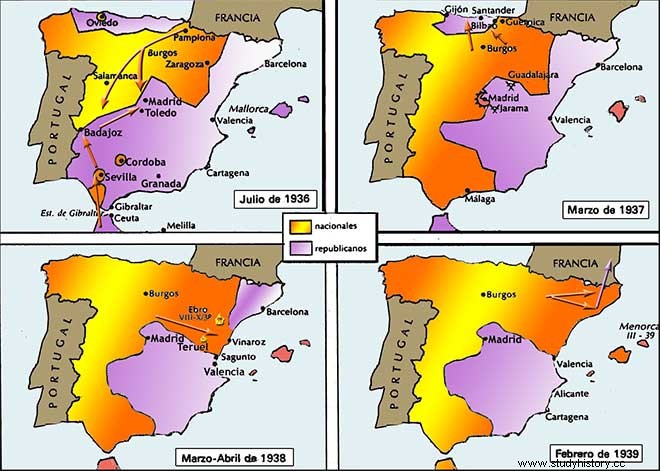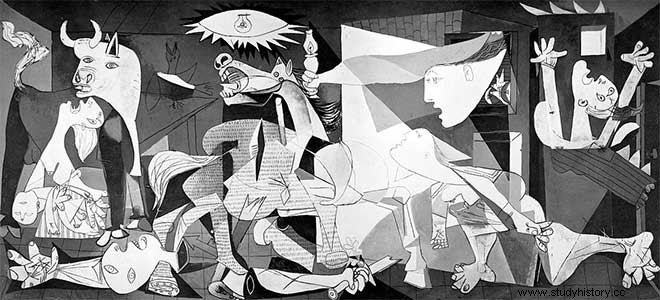The Spanish Civil War occurred between 1936 and 1939, caused by a climate of internal turmoil due to the country's economic, political and social situation.
There is a coup d'état by General Primo de Rivera, in which measures are taken such as the suspension of the 1876 Constitution, the end of parliament, etc., which are not well received even by his party who force him to resign. Dictator Primo de Rivera.
The Second Republic is proclaimed and a new constitution is approved, this stage did not stabilize through 13 governments in 5 years. In the 1936 elections, the left gained power, but clashes continued between left and right that led to the execution of a leftist lieutenant, receiving as a response the assassination of the leader of the right-wing opposition, starting the Civil War with the uprising led by General Francisco Franco, who with the support of the fascist governments of Germany and Italy wins the war, appointing himself Head of the Spanish State and Generalissimo of the Land, Sea and Air Forces.
1. Background
After the First World War, Spain was going through a difficult political, economic and social situation.
1.1Coup d'état by General Primo de Rivera

Under these conditions, in 1923, General Primo de Rivera decided to launch a coup d'état to free Spain from "professional politicians..., responsible for the period of misfortune and corruption that began in 1898" .
Until then, Spain was a constitutional monarchy, governed by King Alfonso XIII, of the House of Bourbon. Once the coup d'état was carried out, it legalized the situation, recognizing the old-fashioned military dictatorship. He suspends the Constitution of 1876, puts an end to the parliamentary system, distances the old political parties from the political scene, strives to give unity to the country, initiating a vast work of public works; but try to repress the opposition that gained more sympathy.
1.2ProclamationoftheSecondRepublic
However, in 1931, the dictator Primo de Rivera was forced to resign by the people, even by his own party, the Patriotic Union , (a group of conservatives) and the discontent of the Armed Forces. Meanwhile, republican sentiments grew and, in the elections of that year, the republicans, under the slogan of monarchy or republic, obtained a majority in the main cities with which they dominated the Cortes or Parliament. Shortly after, the king himself followed the path of exile.
Then the Second Republic was proclaimed and the Constitution of 1931 was issued. Called for elections, Niceto Alcalá Zamora was elected as president . The new system went through a violent stage, with 13 governments taking turns for five years. The Parliament had to be renewed by elections, three times. Socialists and rightists alternated, as follows:
a. At first there were numerous strikes organized by the leftists and by the uprising of General Sanjurjo. During this period, the nationalization of Church property was decreed.
b. In a second moment, in the elections of 1933, the right triumphed and before the announcement of a government made up of characteristic elements of this tendency, the leftists rose up in arms, in Barcelona, Madrid and Asturias but were defeated.

1.3 Creation of New Political Parties
Faced with this climate of internal turmoil, new parties are born, which aspire to a national renewal. Some young petty-bourgeois students and former students from Madrid and Valladolid founded, in 1931, the JONS (Junta de Offensiva Nacional Sindicalista), with a fascist orientation, which attacked not only the weakness of the government, but also social injustice and oppression, and intended to recover for Spain the former glory of the time of the Catholic Monarchs, of the fifteenth and sixteenth centuries . In their supporter manifesto they asked for:respect for the Catholic tradition, imperialist expansion, return of Gibraltar, Morocco and Algeria, fight against separatist tendencies, abolition of the parliamentary system, dissolution of the Marxist parties, distribution of large estates, organization of bosses and employees in national unions and fight against red violence.
In 1933, the year after Hitler took power, José Antonio Primo de Rivera, son of the dictator, founded another party, the Spanish Falange , made up of the upper bourgeoisie and the Madrid and Lower Andalusian aristocracy, supporters of Germany and Italy. It is properly an anti-party movement. He sympathized neither with the right nor with the left. He thought that on the right there was an intention to preserve an unjust economic order; on the left there was the desire to overthrow the economic system. They believed that “…parties must disappear. No one was born a member of a political party… we fight for a Totalitarian State that distributes its fruits fairly to large and small”. They did not hesitate to use violence to achieve their political ends.
2. Causes
The Spanish civil war lasted three years, from 1936 to 1939, and originated due to the following causes:
2.1 Economic Causes.
Spain was a deeply backward country, with few industries, a very poor peasantry, with unresolved agrarian problems. Much of the land belonged to the Church and the nobility, who had no desire to cede part of their property to the most needy. These injustices created differences and conflicts.
2.2 Social Causes.
A strong labor movement existed on the peninsula and was shaken by numerous and violent conflicts between left and right, between republicans and monarchists. The left (socialists, anarchists, trade unionists and communists) appeared united in a block, the Popular Front, opposed to the ruling classes, the Church and its privileges. The right was basically made up of the JONS, which attacked the decadence of Spain and wanted to recover the ancient glories of the time of the Catholic Monarchs; and, the Spanish Falange, which aspired to distribute its fruits equally to large and small. The threat of violence from the left and the right was continuous. To all this we must add the weakness and instability of the different governments.
2.3 Separatist causes.
Some regions such as Catalonia and the Basque Country harbored autonomous desires. They planned to become an independent state, with its own laws, organization, language and culture. This was due to the ineptitude of the governments to seek new markets for the Catalan industry, in the first years of the century, in substitution of the periods of 1898. Subsequently, separatism was provoked by not acting with authority in the matter of the military and the press This is how the «Catalan Solidarity» appeared, which laid the foundations for an autonomist movement.

3. Process of the Spanish Civil War
In the 1936 elections, the left, grouped in the Popular Front, triumphed widely and Parliament elected Manuel Azaña Díaz as president, replacing Niceto Alcalá Zamora. The new ruler had a devastating attitude against the established classes:Church, army, aristocracy and landowners . However, far from reducing the violence he was unable to control it. Then there were strikes, disorders, confrontations and battles between armed groups from the left and the right. As a result of this confrontation, Lieutenant José Castillo was shot by the right-wingers and, in response, the leftists assassinated José Calvo Sotelo, leader of the right-wing opposition. This was the spark that set fire to the Spanish civil war .

3.1 Start of the Spanish civil war
On July 17, 1936, four days after the assassination of Calvo Sotelo, General Francisco Franco led a general uprising in the Canary Islands , to then go to Spanish Morocco, being seconded by other garrisons in the peninsula.
The military uprising was considered by its protagonists as a statement by the army, "united with the other forces of the nation", to restore public order, the principle of authority and to defend the unity of Spain.
Thus began a bloody civil war between two fronts. On the one hand, the leftists, supported by Russia, France and England and, on the other hand, the rightists, backed by Mussolini's Italy and Hitler's Germany .
The military putschists from Africa crossed the Strait of Gibraltar in August 1936. In September they conquered Toledo, liberating the Francoist soldiers, who were besieged in the Alcázar of Toledo. Shortly after, on October 1 of the same year, Franco was appointed Head of State.

3.2SupportoftheNazisandItalianFascism
From the beginning, the insurgents found strong resistance from the leftists, but the help of Germany and Italy, which came with nearly 100,000 soldiers in favor of Franco, tipped the balance in favor of the rightists. On that occasion, Nazi aviation bombed defenseless towns, such as Guernica , later immortalized in the famous oil painting by the genius of Pablo Picasso.
Against the intervention of the fascist governments, volunteers from all over the world fought, grouped in the "International Brigades". However, they were defeated after heroic actions in Brúñete, where 40,000 soldiers from the contending armies succumbed, Teruel, the Ebro River, the Sanctuary of Santa María de la Cabeza and Barcelona.

3.3 End of the Spanish Civil War
Successive defeats forced President Azaña Díaz to resign. Then Madrid and its brave defenders fell. On April 1, 1939, General Francisco Franco officially announced the end of the war, after having been appointed Head of the Spanish State and Generalissimo of the Land, Sea and Air Forces . Thus began the Francoist dictatorship in Spain, which was to last until 1975, when he was succeeded by Prince Juan Carlos de Borbón, grandson of Alfonso XIII.
4. Consequences of the Spanish Civil War
Many are the consequences of the Spanish civil war, which lasted 986 days, and left deep roots in the peninsula. We will point out the main ones:
4.1 Political Consequences.
a. The attempt to establish the socialist system in Spain was frustrated and the Second Republic was drowned in blood.
b. Victorious Francisco Franco became a dictator, suppressing many freedoms, marginalizing opposition politicians and intellectuals, and later declared himself against the socialist countries.
c. The new regime imprisoned 200,000 opposition Spaniards, expatriated many patriots and sentenced 10,000 men to death, and in Madrid alone executions reached 200 per day.
d. The fascist-type dictatorship caused the exclusion of Spain from the United Nations Organization (UN), delaying the recovery of the country.
and. The civil war reverberated throughout the world, mobilizing volunteer brigades willing to fight.
F. The Spanish war action, both in literature and in art, produced a flare of enthusiasm and political commitments of long and profound duration, even after the Second World War.

4.2 ECONOMIC-SOCIAL CONSEQUENCES.
a. The fight between the Spaniards themselves not only blinded many lives but also ruined the country's economy by diverting important sums of money in the acquisition of food and destroying many towns. Likewise, international isolation prevented the prompt reconstruction of the national economy. It was only after 1960 that the United States supported its development plans.
